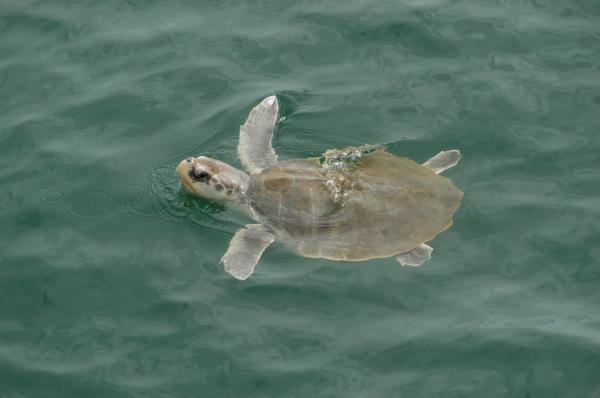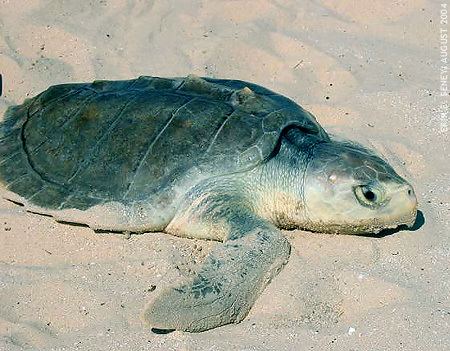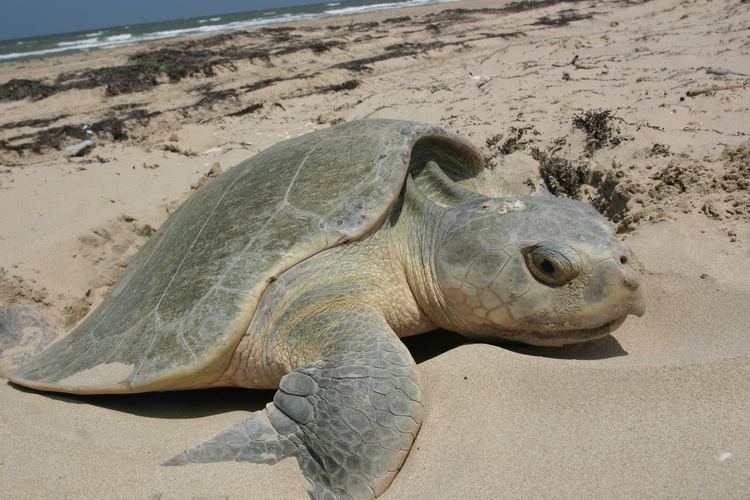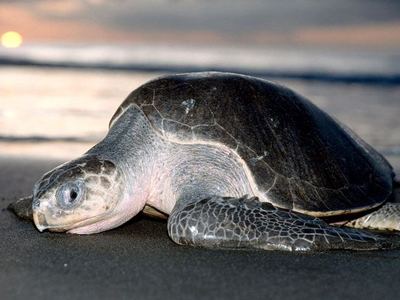Subphylum Vertebrata Scientific name Lepidochelys kempii | Phylum Chordata Order Testudines Genus Lepidochelys Rank Species | |
 | ||
Similar Ridley sea turtle, Turtle, Sea turtle, Olive ridley sea turtle, Flatback sea turtle | ||
Kemp s ridley sea turtle release with oceana
Kemp's ridley sea turtle (Lepidochelys kempii), or the Atlantic ridley sea turtle, is the rarest species of sea turtle and is critically endangered. It is one of two living species in the genus Lepidochelys (the other one being L. olivacea, the olive ridley sea turtle).
Contents
- Kemp s ridley sea turtle release with oceana
- Release of kemp s ridley sea turtles texas parks and wildlife official
- Anatomy
- Distribution
- Feeding
- Life history
- Etymology and taxonomic history
- Conservation
- Oil spills
- References

Release of kemp s ridley sea turtles texas parks and wildlife official
Anatomy

Kemp's ridley is a small sea turtle species, reaching maturity at 58–70 cm (23–28 in) carapace length and weighing only 36–45 kg (79–99 lb). Typical of sea turtles, it has a dorsoventrally depressed body with specially adapted flipper-like front limbs and a beak. Kemp's ridley turtle is the smallest of the sea turtles, with adults reaching a maximum of 75 cm (30 in) in carapace length and weighing a maximum of 50 kg (110 lb). The adult has an oval carapace that is almost as wide as it is long and is usually olive-gray in color. The carapace has five pairs of costal scutes. In each bridge adjoining the plastron to the carapace are four inframarginal scutes, each of which is perforated by a pore. The head has two pairs of prefrontal scales. Hatchlings are black on both sides. Kemp's ridley has a triangular-shaped head with a somewhat hooked beak with large crushing surfaces. This turtle is a shallow-water benthic feeder with a diet consisting primarily of crabs.
Distribution

Kemp's ridley sea turtles generally prefer warm waters, but inhabit waters as far north as New Jersey, They migrate to the Gulf of Mexico and Florida, where they often inhabit the waters off Louisiana.

Their range includes the Atlantic Ocean and the Gulf of Mexico. Almost all females return each year to a single beach—Rancho Nuevo in the Mexican state of Tamaulipas—to lay eggs. The females arrive in large groups of hundreds or thousands in nesting aggregations called arribadas, which is a Spanish word for "arrival."

Some travel as far away as the coast of Ireland, and two individuals managed to journey as far as the coasts of Devonshire.
Feeding

Kemp's ridley turtle feeds on mollusks, crustaceans, jellyfish, fish, algae or seaweed, and sea urchins. Juvenile Kemp's ridleys primarily feed on crabs.
Life history
Juvenile turtles tend to live in floating sargassum seaweed beds for their first years. Then they range between northwest Atlantic waters and the Gulf of Mexico while growing into maturity.
These turtles change color as they mature. As hatchlings, they are almost entirely a dark purple , but mature adults have a yellow-green or white plastron and a grey-green carapace. They reach sexual maturity at the age of 10-12.
The nesting season for these turtles is April to August. They nest mostly on a 16-mile beach in the Mexican state of Tamaulipas and on Padre Island in the US state of Texas, and elsewhere on the Gulf coast. They mate offshore. Gravid females land in groups on beaches in what is commonly called an arribada or mass nesting. They prefer areas with dunes or, secondarily, swamps. The estimated number of nesting females in 1947 was 89,000, but shrank to an estimated 7,702 by 1985.
Females nest two or three times during a season, keeping 10 to 10 days between nestings. Incubation takes 45 to 70 days. On average, around 110 eggs are in a clutch. The hatchlings' sex is decided by the temperature in the area during incubation. If the temperature is below 29.5 °C, the offspring will be mainly male.
Etymology and taxonomic history
These turtles are called Kemp's ridley because Richard Moore Kemp (1825-1908) of Key West was the first to send a specimen to Samuel Garman at Harvard. However, the etymology of the name "ridley" itself is unknown. Prior to the term being popularly used (for both species in the genus), L. kempii at least was known as the "turtle".
At least one source also refers to Kemp's ridley as a "heartbreak turtle". In her book The Great Ridley Rescue, Pamela Philips claimed the name was coined by fishermen who witnessed the turtles dying after being "turned turtle" (on their backs). The fishermen said the turtles "died of a broken heart".
Conservation
Hunting first depleted their numbers, but today, major threats include habitat loss, pollution, and entanglement in shrimping nets.
Mexico first protected Kemp's ridleys in the 1960s. In the United States, Kemp's ridley turtle was first listed under the Endangered Species Conservation Act of 1970 on December 2, 1970, and subsequently under the Endangered Species Act (ESA) of 1973. A binational recovery plan was developed in 1984, and revised in 1992. A draft public review draft of the second revision was published by NOAA Fisheries in March 2010. This revision includes an updated threat assessment.
One mechanism used to protect turtles from fishing nets is the turtle excluder device (TED). Because the biggest danger to the population of Kemp’s ridley sea turtles is shrimp trawls, the device is attached to the shrimp trawl. It is a grid of bars with an opening at the top or bottom, fitted into the neck of the shrimp trawl. It allows small animals to slip through the bars and be caught while larger animals, such as sea turtles, strike the bars and are ejected, thus avoiding possible drowning.
In September 2007, Corpus Christi, Texas, wildlife officials found a record of 128 Kemp's ridley sea turtle nests on Texas beaches, including 81 on North Padre Island (Padre Island National Seashore) and four on Mustang Island. The figure was exceeded in each of the following 7 years (see graph to 2013, provisional figures for 2014 as at July, 118.). Wildlife officials released 10,594 Kemp's ridley hatchlings along the Texas coast that year. The turtles are popular in Mexico, as boot material and food.
Oil spills
Some Kemp's ridleys were airlifted from Mexico after the 1979 blowout of the Ixtoc 1 rig, which spilled millions of gallons of oil into the Gulf of Mexico.
Since April 30, 2010, 10 days after the accident on the Deepwater Horizon, 156 sea turtle deaths were recorded; most were Kemp’s ridleys. Louisiana Department of Wildlife and Fisheries biologists and enforcement agents rescued Kemp's ridleys in Grand Isle. "Most" of the 456 oiled turtles that were rescued, cleaned, and released by US Fish and Wildlife Service were Kemp's ridleys.
Of the endangered marine species frequenting Gulf waters, only Kemp’s ridley relies on the region as its sole breeding ground.
As part of the effort to save the species from some of the effects of the Deepwater Horizon oil spill, scientists took nests and incubated them elsewhere; 67 eggs were collected from a nest along the Florida Panhandle on June 26, 2010, and brought to a temperature-controlled warehouse at NASA’s Kennedy Space Center, where 56 hatched, and 22 were released on 11 July 2010.
The overall plan was to collect eggs from about 700 sea turtle nests, incubate them, and release the young on beaches across Alabama and Florida over a period of months. Eventually, 278 nests were collected, including only a few Kemp' ridley nests.
